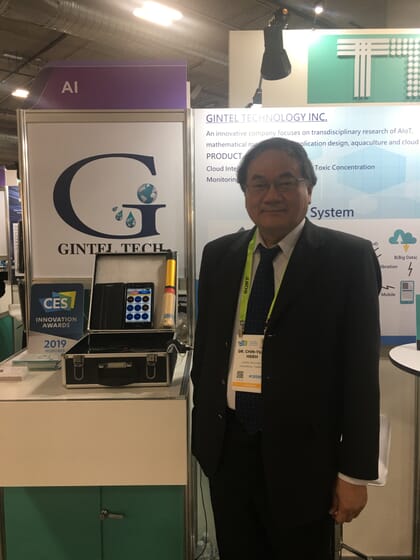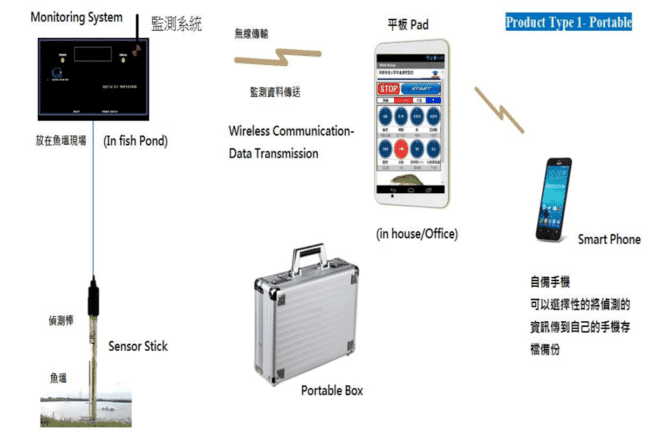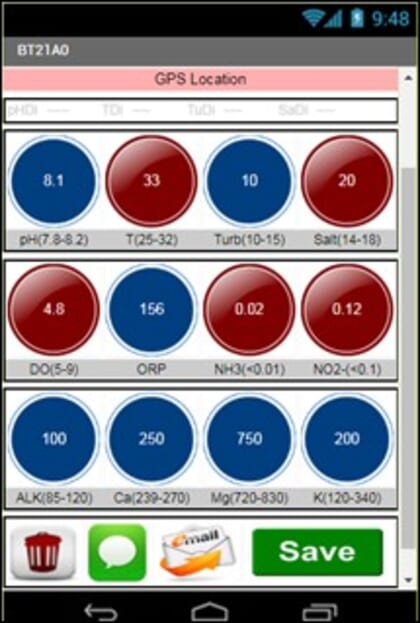Prof Chin-yuan recently returned from the Consumer Electronics Show (CES) in Las Vegas with investment pledges worth over $30 million for water-quality monitoring firm Gintel Tech, a spin-out from Kao Yuan University (KYU) in Taiwan.

He has an impressive CV, as well as being CEO and founder of Gintel Tech, he is also a professor and dean of the college at both the National Kaohsiung Marine University (NKMU) and KYU, while his past employers include Nasa.
You’ve had an illustrious career. What inspired you to start developing ways to improve the performance of the aquaculture sector?
My research for Nasa involved studying the interactive mechanism between physical phenomena and ocean water. The theorem development and research experience has been a great help for studying the water quality of aquaculture. Basically, I’m looking at fish health from a physical, rather than chemical, point of view. It’s very similar to using remote sensing in space engineering.
The mortality rate in many types of aquaculture is very high and some farmed aquatic creatures contain toxins which can be harmful to the health of consumers and the environment.
Since 2016 I've been funded by Taiwan’s ministry of education and ministry of science and technology to study the origins of toxins in aquaponics. We’ve been trying to combine information technology, the integration of hardware and software and Big Data technology to find the answer.
What do you intend to use the investment for?
We are currently discussing the use and management of funds and stock equity. The funding will come from the US and South East Asia. The detail of the investment is not yet finalised, but will be over $30 million and we expect the deal to be finalised this month.
The funds will be used for more advanced research and to develop new commercial products for various uses – such as cloud-based monitoring of the water quality in drinking water, in rivers and lakes, in the factory production line, in factory wastewater, in swimming pools and so on.

How do your systems differ from existing water-quality sensors on the market?
A number of shrimp farmers in South East Asia have already used our products to monitor and track the toxic concentration in the aquaculture water and have been impressed.
By comparison, existing water-quality sensor systems on the market have several disadvantages: they are often slow while ours typically takes a minute; they monitor only a few independent parameters, and tend not to monitor the concentrations of toxic compounds in water, which is what many aquaculture farmers most fear.
As the system is developed to predict and track major sources of toxic concentrations, it can suggest how to use the non-toxic solutions to address these problems.
Other systems use a single sensor to monitor single parameters, so people cannot judge if the data measured is accurate or not. The system accuracy and instrument calibration is always the big challenge in the current market product, but we integrate trans-disciplinary majors – such as AI, IoT [the internet of things], mobile technology, the integration of hardware and software, mathematic models and algorithms – in the system to ensure data accuracy and stability.
In order to increase the calibration efficiency and reduce the calibration cost, the system accuracy is designed to be calibrated in cloud server. This innovative calibration technique has impressed farmers in South East Asia very much.
How easy is it to use effectively?
The beauty of the system is its simplicity – it takes only a few minutes of instruction to use the system. In the portable model, people only need to complete three easy steps:
- Put the sensor in the water and open the app in their mobile device.
- Press the “start” button in the app. The system will send the data to the mobile device automatically by wireless communication. After about one minute all water-parameter data will show up on the app – red indicates abnormal, blue safe.
- Save the data in the app and send to email or cloud server.
In the fixed-type product people use steps one and two described above [which are the steps for operating the portable-type product] the first time [the system is used]. People don’t need to set up the system a second time. The fixed-type system is designed to monitor the water parameters around the clock. The system will monitor, track and save the water-parameter data automatically. All data monitored will be automatically saved in the cloud.

Would it work in marine net pens, or is it primarily designed for tank and pond systems?
The system can be used in any aquaculture system. In the near future we will expand the monitoring and tracking system for use in domestic, industrial and environmental capacities. We also hope more practical problems and [problem-]solving experiences can be discussed and shared.
What sort of remedial action will the system suggest if the sensor detects rising levels of toxins?
Different remedial actions will be suggested in different situations, but the app will give tips on how to solve the problem. The background colour of parameters within the safety range is blue, but this will turn red if any parameter strays from the safety range. The system will also make a noise to alert the user of a potentially dangerous situation.
Can you give us an example?
If the app shows four parameters – such as temperature, salinity, dissolved oxygen and toxic ammonia – are in the red, people can identify that toxic ammonia levels come from the abnormal temperature, salinity and dissolved oxygen parameters. To solve the problem, people would need to turn on water pumps to cool down the water in the pond and also add fresh water to reduce the salinity. In a couple of minutes the dissolved oxygen levels will increase to a safe level and the toxic ammonia concentration will be down to within the safety range. It’s using non-toxic solutions to solve the toxic problems.




